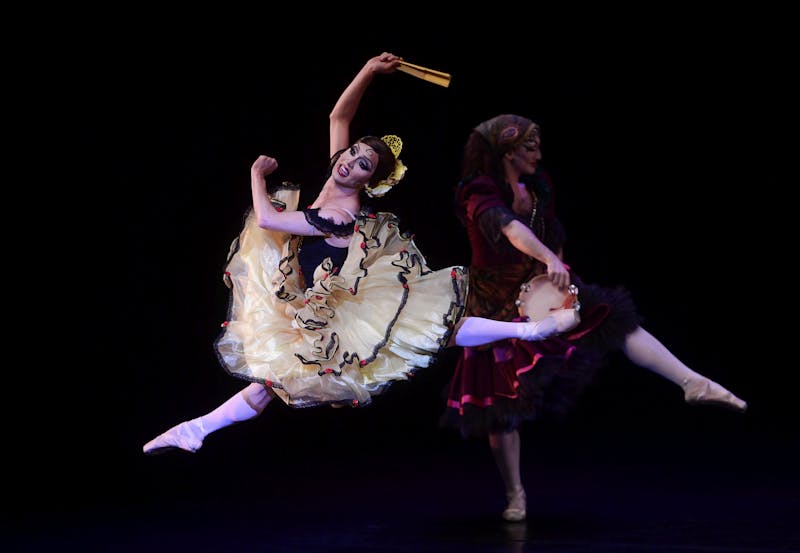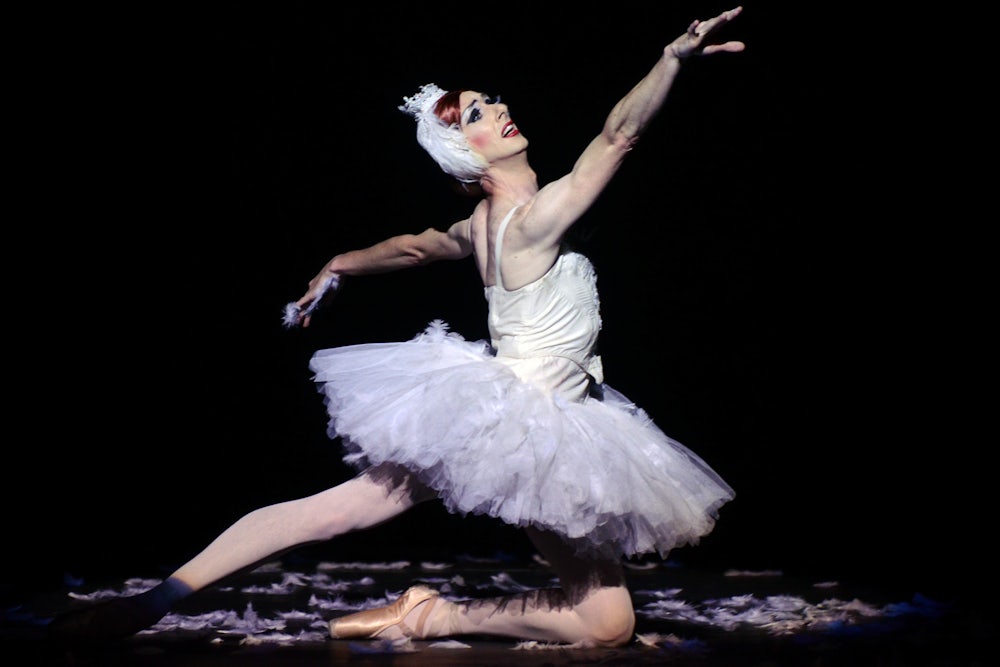Partway through Rebels on Pointe—Bobbi Jo Hart’s marvelous documentary about the all-male, comic, drag dance company Les Ballets Trockadero de Monte Carlo—dancer Raffaele Morra teaches a master class to a roomful of elderly women. Some have shown up in tutus and slippers, others wear sweats, many have never taken a ballet lesson. “That’s not important at all,” Morra reassures them. “What’s important is that it’s you, expressing yourself.” And thus, Morra welcomes them in to the famous Dying Swan solo, choreographed by Mikael Fokine for Anna Pavlova in 1905. He demonstrates the extended bourrées, the tilted head, and the impossibly liquid arms. The women do their best approximations. Technically, they aren’t very good, but it’s a beautiful scene: a flock of unlikely but unabashed swans, flying into history.
The Trocks, as the company is affectionately nicknamed, have been opening up ballet, in one way or another, since 1974. They pay loving tribute to the art form’s ornate glories, but they also satirize it, with jokes that appeal both to balletomanes and relative newcomers. Take their version of the Dying Swan. When the curtain opens, a spotlight darts around, searching for a subject. As Selby Lynn Schwartz has written, you can see this as a “a tribute to Anna Pavlova, whose death was ceremonially marked by a spotlight shining on an empty stage while the Saint-Saëns score played” and, simultaneously, as a gag about inept stagehands. And then, out comes the swan: a man, playing an aging diva, in a fake bun, pointe shoes, and tutu whose feathers keep falling off. She glides smoothly across the stage one moment and, in another, wrenches a stiff arm into place with frustration. Performing as any one of these creatures, the Trocks suggest, takes work.
Ever since Les Ballets Trockadero de Monte Carlo began, reviewers have delighted in their slapstick and inside-ballet humor, celebrated their dancing, and tried to explain their politics: What did it mean that they danced in drag? That men performed roles traditionally performed by women? Soon after their first performance, at the same downtown loft that hosted the West Side Discussion Group, New Yorker critic Arlene Croce asserted that the Trocks weren’t addressing gender roles, but ballet roles, an altogether different topic: “a ballerina isn’t a woman but an abstraction of one.”
This distinction is politically and analytically
useful: It aligns the Trocks squarely with high art, and makes clear that they
aren’t—as some critics have said drag does—making fun of women. But it’s also
wishfully tidy. When, in the Trocks’ Swan
Lake Act II, the corps de ballet fall out of line to throw punches at
Prince Siegfried’s buddy Benno, the joke isn’t just about ballerinas. It’s also
about men and women, flouting and conforming to expectations onstage and off of it, about what happens when “real” impulses break through the sheen of
performance, when the disempowered take revenge.
The Trocks-as-ballerinas have gotten a lot of attention, and rightly so: They amplify “feminine” movements to parodic excess, and do great prima donna antics. But the “men,” as Gia Kourlas says in Rebels on Pointe, are also “delightful,” with puffy wigs, hyperbolic romantic melancholy, and a willingness to get bossed around by ballerinas. Each company member has both a male and female alter ego: Jacques D’aniels, Mikhail Mudkin, Tatiana Youbetyabooktskaya, Innokenti Smoktumuchsky, Nadia Doumiafeyva. The names are funny on their own, even if you don’t catch the references to ballet heroes (Jacques d’Amboise, Mikhail Mordkin) or the sly, historical one-upmanship: In the heyday of the various Ballet Russe companies, up through the 1950s, American and British dancers sometimes adopted foreign stage names to project an air of old-world glamour (Lillian Marks became Alicia Markova; Patricia Meyers, Alexandra Denisova). The Trocks dust off the same old glamour, with a well-timed sneeze.
The Ballet Russe de Monte Carlo, in particular, toured across North America, bringing ballet to audiences who’d often never seen it before. In this, too, they’re models for the Trocks. The company supports itself entirely on box office revenue, which is quite a feat—and, after Jesse Helms’s 1989 attack on “indecent” NEA-funded art, it must’ve been a necessity. For their business model to work, the Trocks keep costs low—a New York apartment serves as the company “office”—and they perform frequently. They tour for a daunting 200 nights a year, nationally and internationally. They are big in Japan. And because they’re funny, they don’t have the same intimidation factor as other classical companies: You can go, and know you’ll be entertained.
Rebels on Pointe traces the broad contours of the Trocks’ history, including the immense losses they experienced during the AIDS epidemic and the happy fact that, today, the troupe includes three married couples in its ranks. “For a gay man of my age,” artistic director Tory Dobrin tells the company in one scene, “to think that that could happen in my lifetime—I didn’t think that it was possible.” The company hasn’t just stayed afloat as minds have begun to open and mores have begun to change; They have helped usher in the change.
When the troupe began, in the midst of the gay liberation movement, drag was still a relatively underground phenomenon. Introducing them on national television in 1977, Shirley Maclaine explained that “up until” the Trocks began performing, “what they do onstage so brilliantly would not only have been unlikely but probably illegal in at least 13 states.” She giggles with obvious delight, but her assertion has gravity: This stuff seemed more or less impossible until the Trocks showed otherwise. When Dobrin joined the Trocks in the 1980s, he says, there were no kids in the audience; now, there are plenty. “In our own way,” he says in the film, “we exposed millions of people to a gay sensibility, and we did it with a lot of talent and a lot of good cheer.”

The Trocks have also served as a chosen family for dancers from across the world who in many cases, haven’t fit into the norms of mainstream society or the ballet world. And it’s in the attention to these dancers that Rebels on Pointe does some of its most moving work, exploring how people hold a space for one another, and how ballet—if we allow it, or make it—can hold a space for us.
Back in South Carolina, where longtime Trockadero star Robert “Bobby” Carter grew up in the 1970s and 1980s, the filmmakers interview him with his parents. Carter used to practice pointework in secret; later on, his dad would ask him when he was going to get a “real job.” But his mother believed in him. She’d grown up picking cotton, knowing that she wanted something more. “I come along, and I have this son, and now, all the things I wished for, it’s what he does.... Sometimes your desires is not necessarily meant for you, but they’re for a future generation.” The “rebels” part of the movie’s title suggests a fight—with culture, with family, with history—and there’s certainly something to that. But the film focuses more on generosity and recognition of the dancers, of performer and audience, of parent and child.
Morra says that his father, now terminally ill, “was always there to help me through all the various steps of getting there.” When he visits his parents in Fossano, Italy, Morra feeds his father by hand; later, we see his mother wheeling his father across the lobby of the theater, coming to watch their son perform.
When Morra dances the Dying Swan that night, the role doesn’t just conjure the artistic histories of Anna Pavlova, or the Bolshoi’s Maya Plisestkaya, who performed the role into her sixties and reportedly loved the Trocks’ version. His swan also recalls the elderly women from his master class, and his own father, losing control of his body. Morra, the ballerina he plays, and the swan itself are all reckoning with time, all trying to be seen, all offering something to their audiences. When she comes out of a turn and notices her audience, her port de bras becomes a gangly wave, and she gives them a big, friendly, grin.
